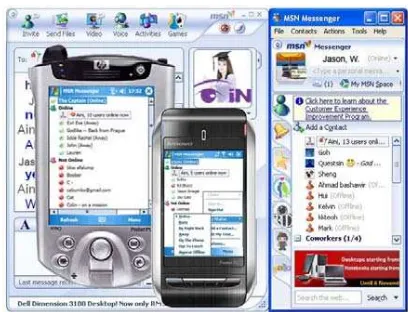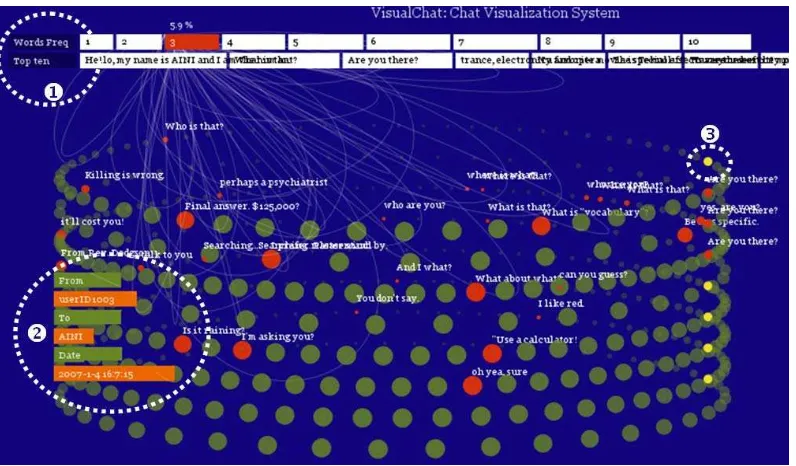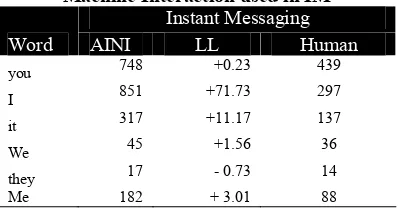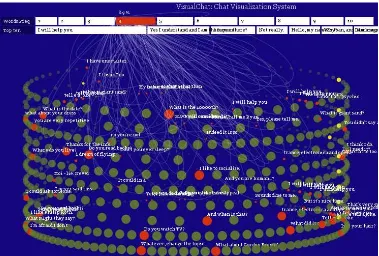Figure 1: AINI and MSN Messenger Interface
VisualChat: A Visualization Tool for Human-Machine Interaction
Ong Sing Goh
Faculty of Information Technology and Communication
University Technical Malaysia Melaka, Malaysia
Email:osgoh@ieee.org
1
Chun Che Fung,
2Kok Wai Wong
School
of Information Technology
Murdoch University, Murdoch, Western Australia 6150
Email: {
1l.fung,
2k.wong }@murdoch.edu.au
Abstract
This paper proposes a technique to analyze and visualize the human-machine interaction corpus using VisualChat. The evaluation used in this study is based on real-time interaction between machines or software robots called AINI (Artificial Intelligent Natural Language Identity) and online human user using MSN Messenger, a web-based messaging system called MSNChat. The result shows that VisualChat is a useful tool to evaluate the human-machine interaction corpus.
1. Introduction
The goal of this study is to evaluate the use of natural language in instant messaging (IM) between human and machine using a visualization tool called VisualChat. The analysis is based on unbiased user expressions expressed in the conversation between AINI and the human user. This study is different from previous studies on human-machine interaction such as Harvard Medical School’s Virtual Patient program, VPbot [1], CMU Nursebot [2] and MIT Media Lab’s OpenMindBot [3]. In the previous studies, they mostly were intended to evaluate or test the functions of the system. Such studies did not allow for the assessment or visualization of the conversation and the language’s characteristics. In this study, only MSNChat interface was used although AINI is also capable to communicate through the WebChat communication channel as reported in references [4, 5]. The MSNChat interface provides more features such as emoticon than the traditional web interface. Such features are inherently closer to the properties of natural language. In addition, other advantages are the inclusion of pre-populated contact lists, integrated authentication, better security and privacy (ethical considerations), free and they are pre-installed on most operating systems.
2. AINI and MSNChat Interface
The AINI conversation architecture has been reported in previous publications [4, 5]. AINI employs an N-tiered architecture that can be configured to work with any web, mobile or other computer-mediated communication applications, such as instant messaging. It comprises a client tier (agent body), an application server tier (agent brain) and a data server tier (agent knowledge).
The user interface, or human-computer interface (HCI), resides in the agent body and it supports three different types of channels of communication, such as Webchat, MobileChat and MSNChat, controlled by the channel service tier. AINI uses HTTP over TCP to connect to the Internet and mobile services to communicate with the users For the MSNChat, AINI connected to the MSN Messenger client In the MSNChat module, we have outlined the conceptual and practical basis for the development of the AINI for MSNDesktopChat, MSNWebChat and MSNMobileChat sub-modules. All these modules are supported by the MSN Messenger protocol as shown in Figure 1.
3.
Evaluation
2008 IEEE/WIC/ACM International Conference on Web Intelligence and Intelligent Agent Technology
978-0-7695-3496-1/08 $25.00 © 2008 IEEE DOI 10.1109/WIIAT.2008.318
131
2008 IEEE/WIC/ACM International Conference on Web Intelligence and Intelligent Agent Technology
978-0-7695-3496-1/08 $25.00 © 2008 IEEE DOI 10.1109/WIIAT.2008.318
Figure 2: An Example of Visualization Chat between Human-Machine in IM using VisualChat
In this evaluation, data collection is via a publicly accessible system which encourages spontaneous human–computer interaction. In this paper, results obtained from real-time human-computer exchanges using Chat are reported. The study is based on the corpus of utterances taken from the IM texts using MSNChat.
The evaluation of this research is also aimed at improving the understanding of the retrieval results
using visualization techniques. Visual representations could accompany textual communication to enhance the interaction. In particular, this is facilitated by computers which are capable to create and share visual objects through graphics and communication software [6]. In this study, visualization tools have been developed to capture the IM characteristics and to facilitate the analysis of the chat activities.
VisualChat was built with Processing1 to visualize and analyze the human-machine conversation logs. The Processing software environment is written in Java. VisualChat is capable to display the timeline of several textual conversations simultaneously and enabling the discovery of utterance lengths and specific reoccurring keywords. The application reads conversation messages in Microsoft MSN XML format and generates a graphical display that allows
1
Processing is programming software can be downloaded at http://processing.org
comparisons between the features of human and machine conversations.
As shown in Figure 2, the system provides an interactive visualization environment that allows the user to navigate across the sequence of conversation. The top left corner (X) shows the statistics such as word frequency and the top ten words extracted from the conversation logs. The bottom left (Y) corner node represents a typical single chat session between AINI and ‘her’ buddy
(userID1003) on 1 April 2007. Each ring (or row) represents a total number of AINI’s buddies. The right most end (Z) with the light colour node (yellow) indicates the starting point of the conversation in the network. Each node is a session of dialogue and the utterance appear collectively as a graph. The population of nodes also increases depending on the number of conversations that have occurred on that particular day. However, the history of the conversation is continually updated as soon as the users return. Thus the visualization gives an illustration of the dominant concepts and their frequency, as well as the intensity of the communication between human users and the conversation agents.
4.
An Example of Conversation Log
A Chatlog System has been developed using MySQL to store user messages to a secondary storage located at the agent knowledge in the data layer. The storage provides real-time archiving of
the chat messages so that they can be searched by keywords and user ID. This also allows topic-based retrieval and replay of the chat sessions. These chat messages are essentially plaintext messages that are quite small in comparison with images, videos, or documents. These plaintext messages, also known as instant messages, are the regular messages sent between the chatting buddies on MSN messenger. The history of the conversation can be extracted and saved in XML format for the analysis using the VisualChat tool. An example of the XML format is shown in Figure 3.
<Message Date="2007-1-3" Time="21:57:54" SessionID="1">
<From>
<User FriendlyName="userID1001"/> </From>
<To>
<User FriendlyName="AINI"/> </To>
<Text Style="font-family:MS Shell Dlg; color:#000000;"> Hey , nice to meet u. How I can call u?</Text>
</Message>
<Message Date="2007-1-3" Time="21:57:57" SessionID="1">
<From>
<User FriendlyName="AINI"/> </From>
<To>
<User FriendlyName="userID1001"/> </To>
<Text Style="font-family:MS Shell Dlg; color:#000000;"> just call me ommer </Text> </Message>
Figure 3: An Example of ChatLog Session between AINI and Human Buddy “userID1001”
5.
Results
The data collected from human-machine interaction was analyzed using techniques from Conversation Analysis [9]. Conversation Analysis is a method originally used for analyzing spoken conversation between humans. The techniques are now used for analyzing the text chat in human-machine conversations. Through an examination of the transcripts, Conversation Analysis derives the coherence from the sequences of utterances.
Pronouns occur more frequently in conversation compared to written text. This is shown in Table 1 by comparing AINI chats with 65 buddies reported in reference [5]. There is significant difference between the frequencies in AINI and human conversation in IM. AINI scored higher in log likelihood (LL) on the singular first-person pronoun “I” (LL: +71.73), second-person pronoun “you” (LL: +0.23), third-person pronoun “we” (LL: +1.56) and the objective personal pronouns “it” (LL: +11.17), and “me” (LL: +3.0`).
Table 1: Frequency List of Pronouns Human-Machine Interaction used in IM
Instant Messaging
LL: Log Likelihood, indicating the distinctiveness (or significance of the difference) between the frequencies in IM corpus (human vs machine).
It is observed that pronouns are used more often by AINI. For example, in the bigrams analysis, discourse verbs such as I am (1.10%), do you (0.90%), are you (0.60%), tell me (0.30%) occurred more frequently in AINI. To simulate human trust and expressions during the chat, AINI frequently uses personal and polite words such as I will (24 times), yes I (33 times), I love (8 times). Even in the n-gram analysis, words along the lines of nice are used with more prominence in the AINI conversation, such as nice work if you (LL: +5.9), nice to meet you (LL: +10.7), nice I guess flowery (LL: +7.3) appeared more often in AINI, to give an impression of human feelings. Nass [10] suggested that the better a computer’s use of language, the more polite people will be to it. Discovery of information in human-machine interaction which could not be seen before can also be visualized using VisualChat as shown in Figure 4. Graphical exploration has the advantage to highlight some features in the communication such as humanness interaction by using “pronouns”. The color intensity of the text varies according to the frequency. Higher frequency words are brightly colored, while the ones with lower frequency are less bright.
6.
Conclusions
Based on the proposal and evaluation described in this paper, a statistical based approach supported by a visualization tool enhanced the visualization of the common communication characteristics found in the human-machine interaction corpus on the web-based system. The evaluation suggested that IM conversations display considerable variations between human-human and human-machine. The contributions in this paper are the identification of the needs to provide improved communication in the
Figure 4: Visualization of the Pronouns used in the IM Human-Machine Interaction
natural language technologies and advances in the interaction between humans and conversation systems.
References:
[1] G. Weber, "Data representation and algorithms for biomedical informatics applications," in Division of Engineering and Applied Sciences Cambridge, Massachusetts: Harvard
University, 2005.
[2] C. Torrey, A. Powers, S. Fussell, and S. Kiesler, "Exploring Adaptive Dialogue Based on a Robot's Awareness of Human Gaze and Task Progress," in Human-Robot Interaction (HRI'07), 2007.
[3] S. Rao, S. Garg, H. Lieberman, and H. Liu, "Commonsense via Instant Messaging," Massachusetts Institute of Technology, 20 July 2007, http://ocw.mit.edu/NR/temp/5C7CF160-
84C0-4E56-BD32-5F36B6CCE2AE/0/proj_file9_wor.pdf.
[4] O. S. Goh, C. C. Fung, and K. W. Wong, "Query Based Intelligent Web Interaction with Real World Knowledge," New Generation Computing, vol. 26, pp. 3-22, 2008.
[5] O. S. Goh, C. C. Fung, A. Depickere, and K. W. Wong, "An Analysis of Man-Machine Interaction in Instant Messenger," in Advances in Communication Systems and Electrical
Engineering. vol. 4, X. Huang, Y.-S. Chen, and S.-I. Ao, Eds. US: Springer, 2008, pp. 197-210. [6] J. Donath, " A semantic approach to
visualizing online conversations,"
Communications of the ACM, vol. 45, pp. 45-49, 2002.
[7] P. Neumann, S. Schlechtweg, and S.
Carpendale, "Arctrees: Visualizing relation in hierarchical data," in Eurographics - IEEE VGTC Symposium on Visualization, 2005. [8] N. Rojas, "MSN history visualization,"
Rhizome.org, 12 August 2007,
http://rhizome.org/object.php?45393. [9] A. Garcia and J. Jacobs, "The eyes of the
beholder : Understanding the turn-taking system in quasi-synchronous computer mediated communication.," Research on Language and Social Interaction, vol. 32, pp. 337-367, 1999.
[10] C. Nass, "Etiquette inequality: Exibitions and expectations of computer politeness.," Communications of the ACM, vol. 47, pp. 35-37, 2004.



